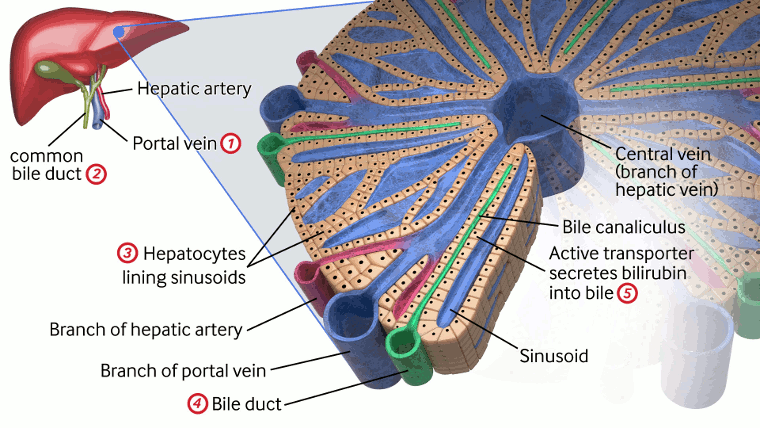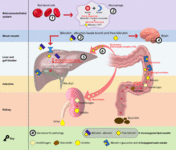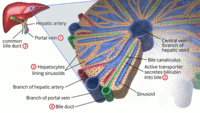Images and videos
Images

Neonatal jaundice
Metabolic pathway of bilirubin with pathologies relating to unconjugated hyperbilirubinemia. 1. ABO incompatibility, Rhesus incompatibility, shorter RBC lifespan in neonates, bruising during delivery; 2. induced by inflammatory mediators associated with comorbidities of prematurity (e.g., respiratory distress syndrome, infection); 3. dissociation increased by acidosis, ketosis, renal failure; 4. permeable blood-brain barrier in term neonates and premature babies; 5. mutation in UGT1A1 gene results in Gilbert syndrome or Crigler-Najjar syndrome I and II; 6. unconjugated bilirubin load increased by decreased gut motility
Created by BMJ Knowledge Centre
See this image in context in the following section/s:

Neonatal jaundice
Detail of liver lobule and its functions, highlighting pathologies that cause conjugated hyperbilirubinemia. Pathologies include: 1. portal vein thrombosis; 2. choledochal cyst; 3. infection (sepsis, E coli urinary tract infection, hepatitis A or B, toxoplasmosis, cytomegalovirus, syphilis, herpes), metabolic (Rotor syndrome, galactosemia, tyrosinemia, alpha-1 antitrypsin deficiency, hypothyroidism, cystic fibrosis, Zellweger syndrome), drugs, idiopathic neonatal hepatitis, total parenteral nutrition, neonatal hemochromatosis, shock/hypoxia/ischemia; 4. bile duct paucity, biliary atresia, Alagille syndrome, idiopathic neonatal cholestasis, progressive familial intrahepatic cholestasis, inspissated bile syndrome; 5. MRP2 (also known as ABCC2) gene mutations on the canalicular membrane of hepatocytes result in Dubin-Johnson syndrome, absence of OATP1B1 and OATP1B3 at the sinusoidal membrane of hepatocytes result in Rotor syndrome
Created by BMJ Knowledge Centre
See this image in context in the following section/s:
Use of this content is subject to our disclaimer

